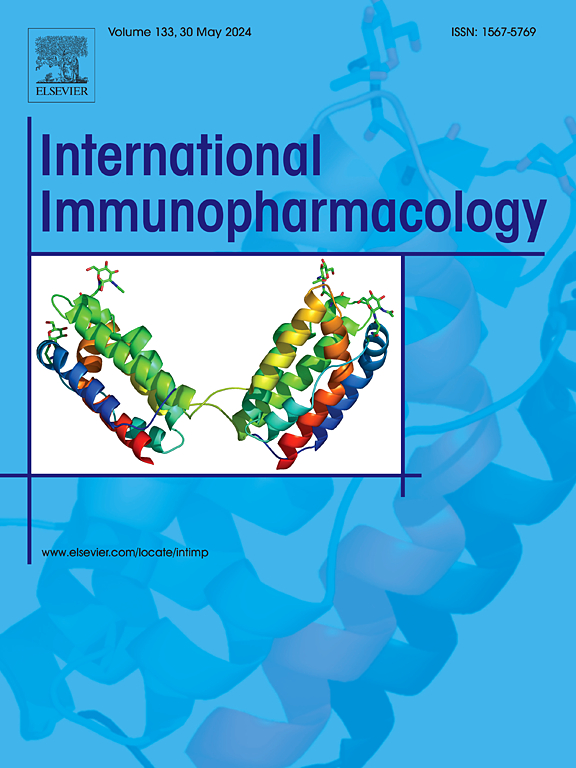Microglial HO-1 aggravates neuronal ferroptosis via regulating iron metabolism and inflammation in the early stage after intracerebral hemorrhage
IF 4.8
2区 医学
Q2 IMMUNOLOGY
引用次数: 0
Abstract
Heme oxygenase 1 (HO-1), an enzyme involved in heme catabolism, has been shown upregulated in microglia cells and plays a critical roles in neurological damages after intracerebral hemorrhage (ICH). However, the mechanisms by which HO-1 mediates the neuronal damages are still obscure. Here, our findings demonstrate that HO-1 over-expression exacerbates the pro-inflammatory response of microglia and induces neuronal ferroptosis through promoting intracellular iron deposition in the ICH model both in vitro and in vivo. Furthermore, in the co-cultured ICH model in vitro, we verify that HO-1 over-expression disrupts the balance of iron metabolism in microglia, which increases the iron efflux to the extracellular space and promotes iron ion uptake in neurons, leading to lipid peroxidation injury and further contributing to neuronal ferroptosis. Moreover, the specific ferroptosis inhibitor Ferrostatin-1 (Fer-1) treatment could mitigate the damages in the co-cultured HT22 cells that caused by HO-1 over-expression in microglia, and improve the neurological function in the ICH model in mice. By shedding light on the mechanisms of aggravating neuronal ferroptosis due to HO-1 overexpression in the early stages after ICH, our study provides insights into the potential therapy of targeting HO-1 to treat ICH.

脑出血后早期小胶质细胞HO-1通过调节铁代谢和炎症加重神经元铁下垂。
血红素加氧酶1 (HO-1)是一种参与血红素分解代谢的酶,在小胶质细胞中表达上调,在脑出血(ICH)后的神经损伤中起关键作用。然而,HO-1介导神经元损伤的机制尚不清楚。本研究表明,HO-1过表达在体外和体内均可通过促进脑出血模型细胞内铁沉积,加剧小胶质细胞的促炎反应,诱导神经元铁凋亡。此外,在体外共培养ICH模型中,我们证实了HO-1的过表达破坏了小胶质细胞中铁代谢的平衡,增加了铁向细胞外空间的外排,促进了神经元对铁离子的摄取,导致脂质过氧化损伤,进一步导致神经元铁凋亡。此外,特异性铁沉滞抑制剂铁抑素-1 (Ferrostatin-1, Fer-1)处理可减轻HO-1在小胶质细胞中过表达对HT22共培养细胞的损伤,改善脑出血模型小鼠的神经功能。通过揭示脑出血后早期HO-1过表达加重神经元铁下垂的机制,我们的研究为靶向HO-1治疗脑出血提供了潜在的治疗方法。
本文章由计算机程序翻译,如有差异,请以英文原文为准。
求助全文
约1分钟内获得全文
求助全文
来源期刊
CiteScore
8.40
自引率
3.60%
发文量
935
审稿时长
53 days
期刊介绍:
International Immunopharmacology is the primary vehicle for the publication of original research papers pertinent to the overlapping areas of immunology, pharmacology, cytokine biology, immunotherapy, immunopathology and immunotoxicology. Review articles that encompass these subjects are also welcome.
The subject material appropriate for submission includes:
• Clinical studies employing immunotherapy of any type including the use of: bacterial and chemical agents; thymic hormones, interferon, lymphokines, etc., in transplantation and diseases such as cancer, immunodeficiency, chronic infection and allergic, inflammatory or autoimmune disorders.
• Studies on the mechanisms of action of these agents for specific parameters of immune competence as well as the overall clinical state.
• Pre-clinical animal studies and in vitro studies on mechanisms of action with immunopotentiators, immunomodulators, immunoadjuvants and other pharmacological agents active on cells participating in immune or allergic responses.
• Pharmacological compounds, microbial products and toxicological agents that affect the lymphoid system, and their mechanisms of action.
• Agents that activate genes or modify transcription and translation within the immune response.
• Substances activated, generated, or released through immunologic or related pathways that are pharmacologically active.
• Production, function and regulation of cytokines and their receptors.
• Classical pharmacological studies on the effects of chemokines and bioactive factors released during immunological reactions.

 求助内容:
求助内容: 应助结果提醒方式:
应助结果提醒方式:


